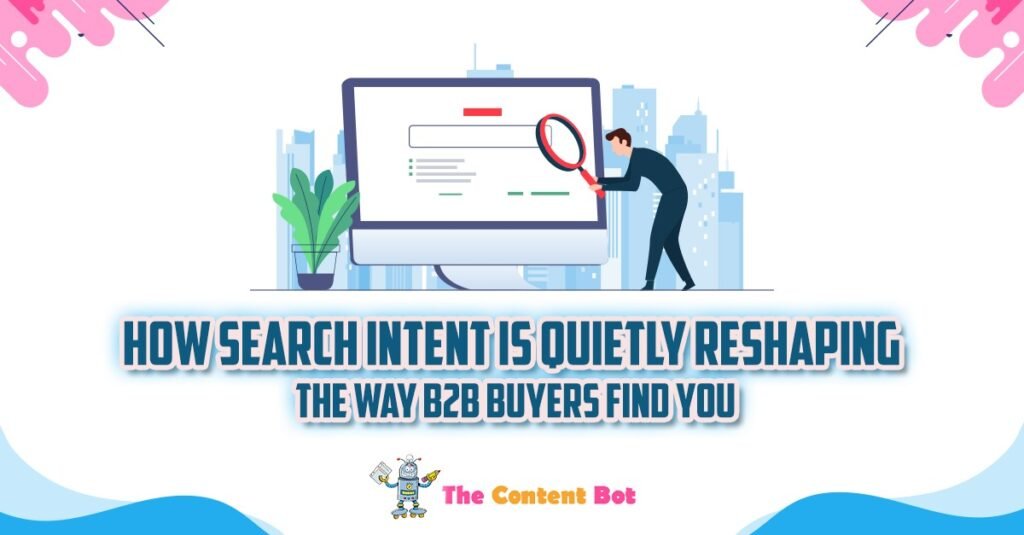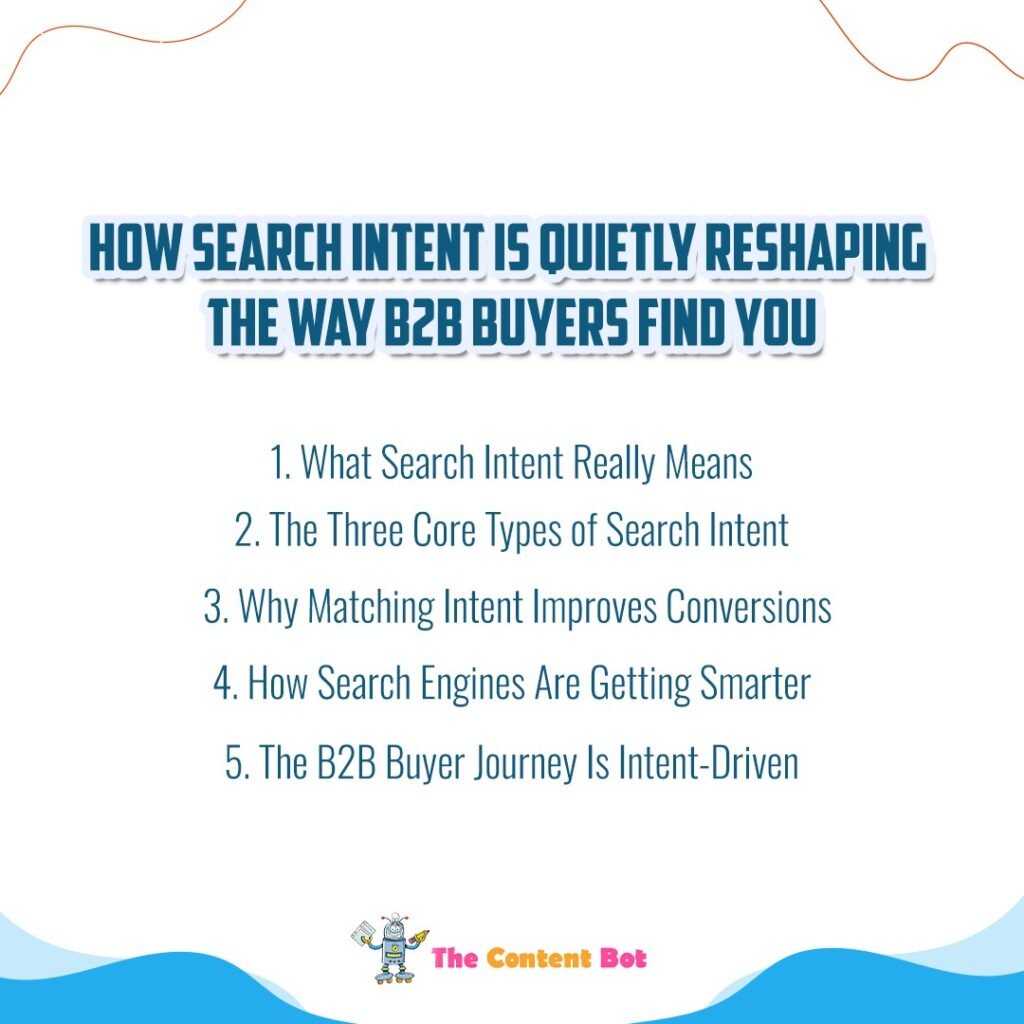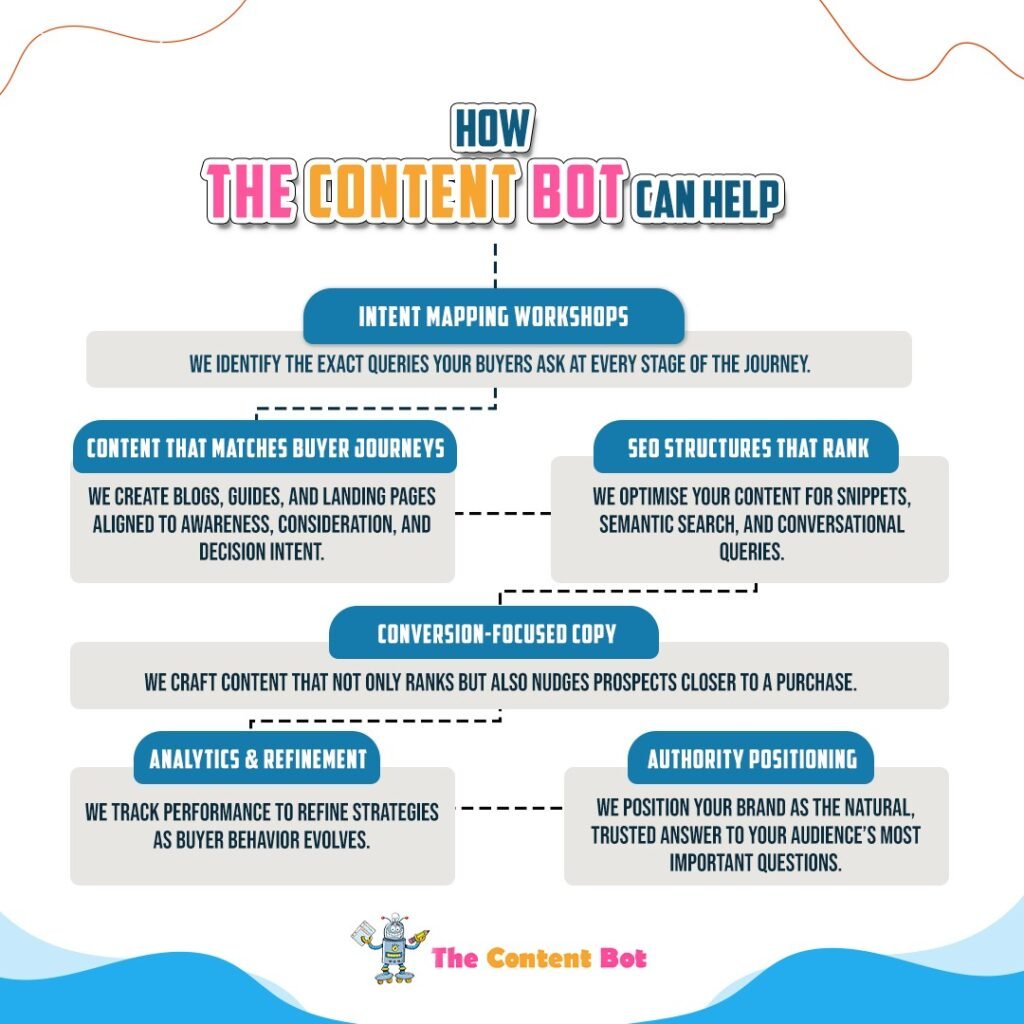
B2B Search Intent 2025 In B2B, it’s no longer about who shouts the loudest it’s about who answers the right question at the right time. Search intent has quietly become the backbone of modern SEO, reshaping how buyers discover solutions. If your content doesn’t match what your audience is really looking for, you’re invisible. This blog explores the types of search intent, why they matter, and how to align your content strategy with buyer journeys.
1. What Search Intent Really Means
Search intent is the “why” behind a query. A buyer typing “what is workflow automation” isn’t ready to purchase they want education. A query like “best workflow automation tools pricing” signals buying intent. Businesses that don’t distinguish between the two waste content and ad spend targeting the wrong stage.
Key Insight: Ranking for keywords without matching intent is like showing up to the wrong meeting you won’t close deals.
2. The Three Core Types of Search Intent
There are three main categories of search intent: informational (“how to improve sales pipeline”), navigational (“HubSpot login”), and transactional (“best CRM software pricing”). Mapping your content to each intent type ensures you cover buyers from awareness to decision.
Key Insight: B2B buyers move through stages your content must guide them at every step.

3. Why Matching Intent Improves Conversions
Content aligned with intent reduces friction. Instead of pushing a product demo on someone still learning, you provide helpful guides. When they’re ready to buy, they already trust you. This alignment shortens sales cycles and makes your brand the natural choice when decisions happen.
Key Insight: Content that matches intent doesn’t just rank it converts.
4. How Search Engines Are Getting Smarter
Google’s AI-driven algorithms (like RankBrain and BERT) understand context better than ever. That means keyword stuffing is dead. Search engines evaluate whether your content actually answers the query in depth. If your page doesn’t serve intent, you won’t rank, no matter how many times you repeat the keyword.
Key Insight: Modern SEO is intent-first Google rewards content that truly solves user needs.
5. The B2B Buyer Journey Is Intent-Driven
B2B buyers don’t impulse-buy they research, compare, and justify decisions internally. Each query they make reflects a stage of that journey. Brands that publish content for each stage awareness, consideration, decision guide buyers naturally into their pipeline. Those that don’t? They get bypassed.
Key Insight: Search intent mirrors the buyer journey. Covering all stages keeps prospects moving toward you.

How The Content Bot Can Help
At The Content Bot, we design content ecosystems built around buyer intent, not just keywords. Here’s how we do it:
- Intent Mapping Workshops -We identify the exact queries your buyers ask at every stage of the journey.
- Content That Matches Buyer Journeys -We create blogs, guides, and landing pages aligned to awareness, consideration, and decision intent.
- SEO Structures That Rank -We optimise your content for snippets, semantic search, and conversational queries.
- Conversion-Focused Copy -We craft content that not only ranks but also nudges prospects closer to a purchase.
- Analytics & Refinement -We track performance to refine strategies as buyer behavior evolves.
- Authority Positioning -We position your brand as the natural, trusted answer to your audience’s most important questions.
With us, SEO stops being about traffic and becomes about qualified, intent-driven leads.
Frequently Asked Questions
1. What is search intent in simple terms? It’s the reason behind a search whether someone is learning, exploring, or ready to buy.
2. Why does search intent matter for B2B SEO? Because buyers go through long journeys. If your content doesn’t match their stage, they’ll move on.
3. How do I identify my audience’s search intent? By analyzing keywords, queries, and competitor rankings and mapping them to the buyer journey.
4. Do keywords still matter if intent is more important? Yes, but only when paired with the right context and content that answers intent fully.
5. Can search intent improve conversions? Absolutely. Intent-matched content builds trust and nurtures buyers until they’re ready to act.
6. Is search intent relevant for small businesses? Yes. In fact, small businesses can compete more effectively by targeting niche intent queries.
Here’s How This Helps
SaaS Firm’s Awareness Content Win
A SaaS startup created “what is workflow automation” guides to capture informational intent. These blogs built trust and funneled readers into demo requests months later.
Consulting Agency’s Mid-Funnel Fix
A consulting firm focused only on awareness content. By adding comparison blogs (“X vs Y services”), they captured buyers in consideration stage and doubled conversions.
IT Services Provider’s Decision Content
An IT company ranked for “benefits of cloud migration” but not for “cloud migration pricing.” After creating transactional landing pages, inbound leads rose by 40%.
Local B2B Supplier’s Semantic Win
A supplier optimised content for “best steel suppliers near me” and “affordable steel supply contracts.” Their site started ranking higher for both informational and transactional queries.
Search intent is the hidden engine of modern SEO. Keywords alone won’t get you ranked and they won’t get you conversions. By aligning content with buyer intent at every stage, you turn SEO into a pipeline-builder, not just a traffic source. At The Content Bot, we help B2B businesses design intent-first strategies that connect, convert, and compound over time.

